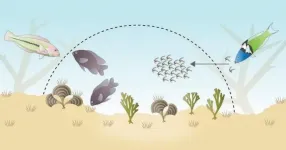Researchers uncover new information on the effects of antidepressants
The drugs bind directly to a brain-derived neurotrophic factor receptor without help from serotonin
2021-02-18
(Press-News.org) The effects of selective serotonin reuptake inhibitors (SSRIs) and other conventional antidepressants are believed to be based on their increasing the levels of serotonin and noradrenalin in synapses, while ketamine, a new rapid-acting antidepressant, is thought to function by inhibiting receptors for the neurotransmitter glutamate.
Neurotrophic factors regulate the development and plasticity of the nervous system. While all antidepressants increase the quantity and signalling of brain-derived neurotrophic factor (BDNF) in the brain, the drugs have so far been thought to act on BDNF indirectly, through serotonin or glutamate receptors.
A new study published this week in Cell demonstrates, however, that antidepressants bind directly to a BDNF receptor known as TrkB. This finding challenges the primary role of serotonin or glutamate receptors in the effects of antidepressants.
The international study, which was collaboratively led by the Neuroscience Center and the Department of Physics at the University of Helsinki, investigated the binding of antidepressants from different drug classes to the TrkB receptor. All the antidepressants examined, including fluoxetine (an SSRI), imipramine (a tricyclic antidepressant) and the rapid-acting ketamine interacted with TrkB.
"We found that all antidepressants boost BDNF signalling by binding to its TrkB receptor. This signalling is necessary for the cellular and behavioural effects of antidepressants in our experimental models. The effects of antidepressant on plasticity do not therefore require increases in the serotonin levels or the inhibition of glutamate receptors, as previously thought," says Professor Eero Castrén, the principal investigator of the study.
Molecular modelling helped to locate the binding site of antidepressants
The binding site of antidepressants in the transmembrane region of TrkB was identified through molecular modelling, performed in Professor Ilpo Vattulainen's research group at the Department of Physics, University of Helsinki. Biochemical binding studies and mutations introduced in the TrkB receptor verified the site.
Molecular modelling also demonstrated that the structure of TrkB is sensitive to the cholesterol concentration of the cell membrane. TrkB is displaced in cholesterol-rich membrane compartments, such as synaptic membranes.
"The drug binding stabilises dimers, structures composed of two TrkB receptors, inhibiting the displacement of the TrkB receptors and increasing their quantity in synaptic cell membranes, which boosts the effects of BDNF. That is to say that the drugs do not directly activate TrkB. Instead, they sensitise the receptor to the effects of BDNF," Castrén explains.
In addition to findings pertaining to the effects of antidepressants, the study produced a substantial amount of new information on the structure and function of the growth factor receptor.
Why does ketamine have such a rapid effect?
Ketamine, which has been used as an anaesthetic, is becoming increasingly utilized as an antidepressant. The researchers were surprised to find that both slow-acting SSRIs and rapid-acting ketamine act by binding to the same site in TrkB.
SSRI drugs bind to the serotonin transporter protein much more avidly than to TrkB, but the binding of ketamine to the glutamate receptor and TrkB occurs at similar drug concentrations.
"Previous studies have shown that in SSRI therapy, drugs gradually reach the high brain concentration needed for binding to the TrkB receptor, whereas intravenously administered ketamine and esketamine as a nasal spray reach the level needed for binding quickly, in a matter of minutes. The difference in the onset of action for SSRIs and ketamine may be caused by their different capacity to reach in the brain the concentration needed for binding with TrkB receptors," Castrén says.
INFORMATION:
ELSE PRESS RELEASES FROM THIS DATE:
2021-02-18
NEW YORK, NY (Feb. 18, 2021)--A new study from Columbia University Vagelos College of Physicians and Surgeons has found that suicide mortality can be reduced by a Federally coordinated approach employing scientifically proven options.
Columbia researchers J. John Mann, MD, Christina A. Michel, MA, and Randy P. Auerbach, PhD, conducted a systematic review, determining which suicide prevention strategies work and are scalable to national levels.
The study, "Improving Suicide Prevention Through Evidence-Based
Strategies: A Systematic Review," was published online in the American Journal of Psychiatry.
The researchers found that screening school children or the general population for those at risk for suicide--the ...
2021-02-18
While the human brain has over 400 miles of total vasculature, little is known about the tiny capillaries that make up much of this intricate labyrinth of blood vessels critical for delivering oxygenated blood and nutrients to billions of brain cells.
According to Dr. Andy Shih, a principal investigator in the Center for Developmental Biology and Regenerative Medicine at Seattle Children's Research Institute, understanding how this vast network regulates blood flow in the brain could hold the key to new treatments for neonatal and childhood neurologic conditions, such as stroke and hypoxia, and issues of aging like dementia and Alzheimer's disease.
"Insufficient blood flow contributes to many of the common neurologic problems seen in children and adults," he said. "Yet, ...
2021-02-18
Acres of asphalt parking lots, unshaded roads, dense apartment complexes and neighborhoods with few parks have taken their toll on the poor. As climate change accelerates, low-income districts in the Southwestern United States are 4 to 7 degrees hotter in Fahrenheit -- on average -- than wealthy neighborhoods in the same metro regions, University of California, Davis, researchers have found in a new analysis.
This study provides the most detailed mapping yet of how summer temperatures in 20 urban centers in California, Nevada, Utah, Arizona, Colorado, New Mexico and Texas affected different neighborhoods between 2018 and 2020. The researchers found even greater heat disparities in California than in other states. The largest disparities showed ...
2021-02-18
PHILADELPHIA (February 18, 2021) - With stressors mounting daily on the health care system due to the COVID-19 pandemic, a de-prioritization of the childbearing family has been noted. Their care has changed, resulting in mothers forced to go through labor and birth without their partners, parents barred from NICU visitation, and discharge of mothers and newborns early without enough expert lactation care. There is great concern that these changes in childbearing families' care may become permanent - to the detriment of the health of both mother and ...
2021-02-18
American values, attitudes and activities have changed dramatically during COVID-19, according to a new study of online behavior.
Researchers from UCLA and Harvard University analyzed how two types of internet activity changed in the U.S. for 10 weeks before and 10 weeks after March 13, 2020 -- the date then-President Donald Trump declared COVID-19 a national emergency. One was Google searches; the other was the phrasing of more than a half-billion words and phrases posted on Twitter, blogs and internet forums.
The study is the lead research article in a special issue of the journal Human Behavior and Emerging Technologies ...
2021-02-18
ORLANDO, Feb. 18, 2021 - University of Central Florida researchers are homing in on the cause of a major disease of sea turtles, with some of their latest findings implicating saltwater leeches as a possible factor.
The disease, known as fibropapillomatosis, or FP, causes sea turtles to develop tumors on their bodies, which can limit their mobility and also their health by interfering with their ability to catch and eat prey.
While the cause of FP isn't known, saltwater leeches have been suspected to play a role due to their frequent presence on areas of sea turtles where FP tumors often develop, such as on their eyes, mouths and ...
2021-02-18
MALVERN, Pa. -- Doctors and healthcare workers may one day use a machine learning model, called deep learning, to guide their treatment decisions for lung cancer patients, according to a team of Penn State Great Valley researchers.
In a study, the researchers report that they developed a deep learning model that, in certain conditions, was more than 71 percent accurate in predicting survival expectancy of lung cancer patients, significantly better than traditional machine learning models that the team tested. The other machine learning models the team ...
2021-02-18
HOUSTON -- The first randomized Phase II clinical trial to report on single and combined neoadjuvant immune checkpoint inhibitor therapy in stage I-III non-small cell lung cancer (NSCLC) found combination therapy produced a significant clinical benefit, as assessed by major pathologic response (MPR) rate, as well as enhanced tumor immune cell infiltration and immunological memory. Researchers from The University of Texas MD Anderson Cancer Center published the study results today in Nature Medicine.
The NEOSTAR trial tested combined neoadjuvant therapy of nivolumab plus ipilimumab, as well as neoadjuvant nivolumab monotherapy in patients with operable NSCLC. The trial met its prespecified primary endpoint efficacy threshold in ...
2021-02-18
Throughout nature, there are instances of animals aiding one another and living together in mutually beneficial relationships that have helped shape the world's landscapes and biodiversity.
These domesticator-domesticate relationships form when one species provides multigenerational support to another species in exchange for a resource or service that benefits both species. An example of this type of relationship is how early humans domesticated gray wolves. The wolves were attracted to the human encampments, which provided them with protection and resources, and the wolves, in turn, helped the humans increase their hunting proficiency.
One area ...
2021-02-18
Richer countries were more likely to see rates of COVID-19 fall faster during the first wave of the pandemic, according to new research published in the journal Frontiers in Public Health.
The study by Anglia Ruskin University (ARU) professors Shahina Pardhan and Nick Drydakis examined economic indicators in 38 European countries, such as Gross Domestic Product (GDP) per capita, life expectancy, and public spending, and the number of new coronavirus cases per million of the population between 1 April and 31 May 2020, using data from Our World in Data based on the seven-day rolling average of new cases for each country.
A significant negative correlation ...
LAST 30 PRESS RELEASES:
[Press-News.org] Researchers uncover new information on the effects of antidepressants
The drugs bind directly to a brain-derived neurotrophic factor receptor without help from serotonin




